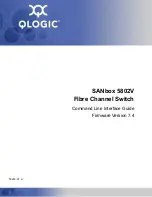
Internet Protocol Security (IPSec)
Internet protocol security (IPSec) is an end-to-end security scheme for protecting IP communications by authenticating and encrypting all
packets in a communication session. Use IPSec between hosts, between gateways, or between hosts and gateways.
IPSec is compatible with Telnet and FTP protocols. It supports two operational modes: Transport and Tunnel.
•
Transport mode — (default) Use to encrypt only the payload of the packet. Routing information is unchanged.
•
Tunnel mode — Use to encrypt the entire packet including the routing information of the IP header. Typically used when creating virtual
private networks (VPNs).
NOTE:
Due to performance limitations on the control processor, you cannot enable IPSec on all packets in a communication
session.
IPSec uses the following protocols:
•
Authentication Headers (AH)
— Disconnected integrity and origin authentication for IP packets
•
Encapsulating Security Payload (ESP)
— Confidentiality, authentication, and data integrity for IP packets
•
Security Associations (SA)
— Necessary algorithmic parameters for AH and ESP functionality
IPSec supports the following authentication and encryption algorithms:
•
Authentication only:
•
MD5
•
SHA1
•
Encryption only:
•
3DES
•
CBC
•
DES
•
ESP Authentication and Encryption:
•
MD5 & 3DES
•
MD5 & CBC
•
MD5 & DES
•
SHA1 & 3DES
•
SHA1 & CBC
•
SHA1 & DES
Configuring IPSec
The following sample configuration shows how to configure FTP and telnet for IPSec.
1
Define the transform set.
CONFIGURATION mode
crypto ipsec transform-set myXform-seta esp-authentication md5 esp-encryption des
2
Define the crypto policy.
CONFIGURATION mode
20
358
Internet Protocol Security (IPSec)
Summary of Contents for S3048-ON
Page 1: ...Dell Configuration Guide for the S3048 ON System 9 11 2 5 ...
Page 137: ...0 Gi 1 1 Gi 1 2 rx Flow N A N A 0 0 No N A N A yes Access Control Lists ACLs 137 ...
Page 142: ...Figure 10 BFD Three Way Handshake State Changes 142 Bidirectional Forwarding Detection BFD ...
Page 241: ...Dell Control Plane Policing CoPP 241 ...
Page 287: ... RPM Synchronization GARP VLAN Registration Protocol GVRP 287 ...
Page 428: ...Figure 53 Inspecting the LAG Configuration 428 Link Aggregation Control Protocol LACP ...
Page 477: ...Figure 73 Configuring Interfaces for MSDP Multicast Source Discovery Protocol MSDP 477 ...
Page 478: ...Figure 74 Configuring OSPF and BGP for MSDP 478 Multicast Source Discovery Protocol MSDP ...
Page 483: ...Figure 77 MSDP Default Peer Scenario 2 Multicast Source Discovery Protocol MSDP 483 ...
Page 484: ...Figure 78 MSDP Default Peer Scenario 3 484 Multicast Source Discovery Protocol MSDP ...
Page 745: ...Figure 104 Single and Double Tag TPID Match Service Provider Bridging 745 ...
Page 746: ...Figure 105 Single and Double Tag First byte TPID Match 746 Service Provider Bridging ...
















































